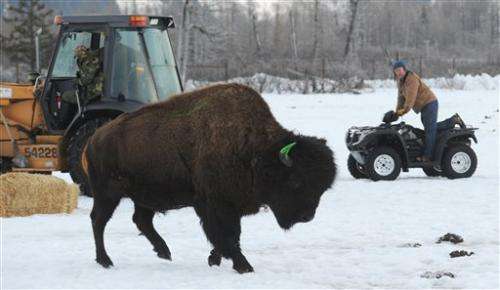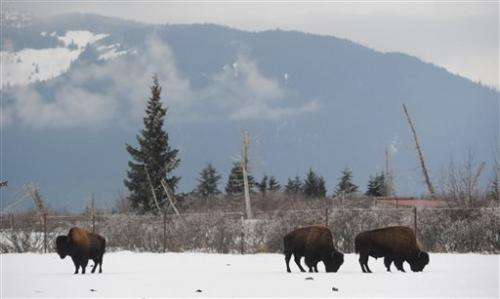Alaska prepares for wood bison return after a century

Alaska wildlife officials are preparing to release North America's largest land mammal into its native U.S. habitat for the first time in more than a century.
The Alaska Department of Fish and Game on Sunday plans to begin moving wood bison from a conservation center south of Anchorage to the village of Shageluk, the staging area for the animals' release into the Innoko Flats about 350 miles southwest of Fairbanks.
A hundred wood bison will be released after they're acclimated in a few weeks.
"This has been an incredibly long project—23 years in the making," biologist Cathie Harms said. "To say we're excited is an understatement."
Wood bison are the larger of two subspecies of American bison but did not roam in Lower 48 states. The smaller subspecies are plains bison, which were not native to Alaska but were introduced to the state in 1928, where they have thrived.
Bull wood bison weigh 2,000 pounds and stand 6-feet-tall at the shoulder. They feed on grasses, sedges and forbs and wider variety of other plants, including Alaska's abundant willow.
Wood bison flourished for thousands of years in Alaska but disappeared in the 1800s or early 1900s. No one knows why.
The state had a strong interest in reintroduction as a source of food for subsistence hunters and as a game animal for sport hunting, but plans ran into a political snag.

In 2008, the state imported 53 wood bison from a national park in Canada, adding to a smaller herd that was held at the Alaska Wildlife Conservation Center in Portage.
However, wood bison are a threatened species and state officials worried that the federal government would designate their new home in the wild as critical habitat, requiring consultation with federal agencies before oil and gas drilling or other development could occur.
The problems were worked out. The U.S. Fish and Wildlife Service in 2013 declared that wood bison reintroduced in Alaska would be considered an experimental population not essential to the continued existence of the species. Wood bison will be managed by state wildlife officials and exempt from certain restrictions in the Endangered Species Act.
The bison will be flown in 20-foot containers that can hold seven adult cows in individual stalls or up to 17 younger bison. Two containers will be trucked Sunday to Anchorage and flown by commercial carrier for the hour flight to Shageluk. A C-130 from Lynden Air Cargo, one of the multiple corporate sponsors involved, can carry two containers each flight.
Half the initial herd moved will be adult cows. About 25 are pregnant.
The rest of the initial herd will be juveniles 2 years old or younger. Bulls will be barged to the area in summer.
The Fish and Game Department does not expect predators to be a problem. Canada has reintroduced five herds, Harms said.
"Wolves don't seem to know what to do with them," she said, and Alaska did not record a bear or a wolf killing a plains bison until nearly 30 years after they were introduced 87 years ago.
The state hopes to complete the flights by Tuesday but will proceed slowly if there are snags. Wood bison are very large, very powerful wild animals, Harms said.
"We're making them do something they don't want to do," she said. "Calming agents" will be available to sedate bison if needed.
Once in Shageluk, the bison will be kept in pens several acres large before release in two or three weeks.
"When they're in good shape, that's when we're going to start opening the door and letting them go," Harms said.
© 2015 The Associated Press. All rights reserved.

















